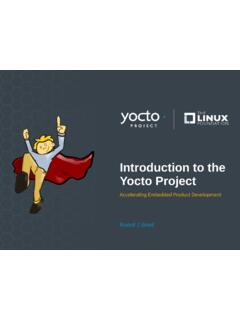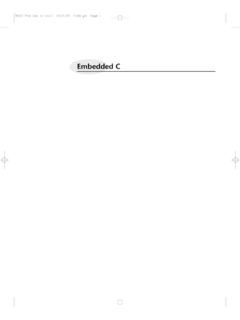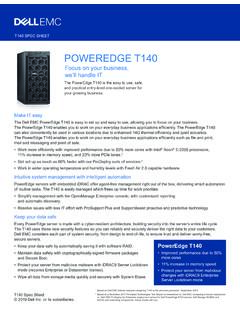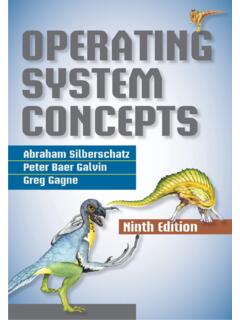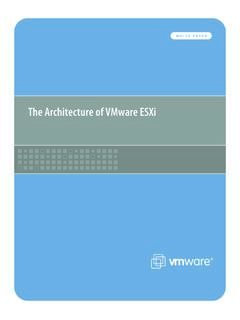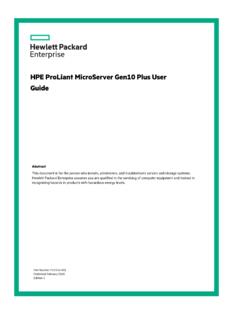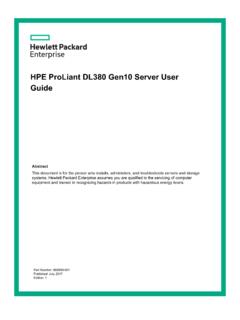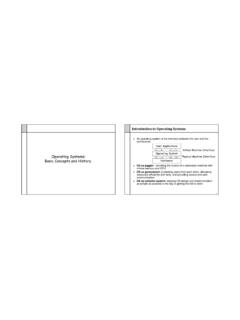Transcription of Comparison of different Operating System - I.T.S
1 Proceedings of National Conference on Recent Advances in Electronics and Communication Engineering (RACE-2014), 28-29 March 2014 1 Comparison of different Operating System Niti gupta 1, Amrita ticku2, Manoj kumar3 [1,2]Faculty: Department of cse at Dronacharya Group Of Institution Knowledge Park-III, Greater Noida, Uttar Pradesh, India [3]Student: Department of cse at Dronacharya Group Of Institution Knowledge Park-III, Greater Noida, Uttar Pradesh, India [1] Abstract- Operating System : In the current era the OS is used in every Mobile, Laptop, Tablets and Desktops. Day by day there is some important in Operating System and every new development give birth to a new Technology and new Operating System .
2 People s requirements are changing as the time change. They want to keep themselves update. Our Paper just gives a refreshing review on Operating System that has been developed. This paper will help to compare Operating Systems by their technology and usage in all aspect so that everyone can choose best according to their requirements. I. INTRODUCTION Operating System (OS) is a collection of software that manages computer hardware resources and provides common services for computer programs. The Operating System is an essential component of the System software in a computer System . Application programs usually require an Operating System to function.
3 Operating System can be defined as A program that acts as an intermediary between a user of a computer and the computer hardware Goals of Operating System Are: Execute user programs and make solving user problems easier Make the computer System convenient to use Use the computer hardware in an efficient manner. Operating systems can be found on almost any device that contains a computer from cellular phones and video game consoles to supercomputers and web servers. ARCHITECTURE OF Operating System Kernel Mode In Kernel mode, the executing code has complete and unrestricted access to the underlying hardware.
4 It can execute any CPU instruction and reference any memory address. Kernel mode is generally reserved for the lowest-level, most trusted functions of the Operating System . User Mode In User mode, the executing code has no ability to directly accesshardware or reference memory. Code running in user mode must delegate to System APIs to access Hardware or memory. As shown in figure:-1. Proceedings of National Conference on Recent Advances in Electronics and Communication Engineering (RACE-2014), 28-29 March 2014 2 Services provided by the Operating System User Interfaces - Means by which users can issue commands to the System .
5 Depending on the System these may be a command-line interface ( sh, csh, ksh, tcsh, etc.), a GUI interface ( Windows, X-Windows, KDE, Gnome, etc. ), or a batch command systems. The latter are generally older systems using punch cards of job-control language, JCL, but may still be used today for specialty systems designed for a single purpose. Program Execution - The OS must be able to load a program into RAM, run the program, and terminate the program, either normally or abnormally. I/O Operations - The OS is responsible for transferring data to and from I/O devices, including keyboards, terminals, printers, and storage devices.
6 File- System Manipulation - In addition to raw data storage, the OS is also responsible for maintaining directory and subdirectory structures, mapping file names to specific blocks of data storage, and providing tools for navigating and utilizing the file System . Communications - Inter-process communications, IPC, either between processes running on the same processor, or between processes running on separate processors or separate machines. May be implemented as either shared memory or message passing, ( or some systems may offer both. ) Error Detection - Both hardware and software errors must be detected and handled appropriately, with a minimum of harmful repercussions.
7 Some systems may include complex error avoidance or recovery systems, including backups, RAID drives, and other redundant systems. Debugging and diagnostic tools aid users and administrators in tracing down the cause of problems. Other systems aid in the efficient operation of the OS: Resource Allocation - CPU cycles, main memory, storage space, and peripheral devices. Some resources are managed with generic systems and others with very carefully designed and specially tuned systems, customized for a particular resource and Operating environment. Accounting - Keeping track of System activity and resource usage, either for billing purposes or for statistical record keeping that can be used to optimize future performance.
8 Protection and Security - Preventing harm to the System and to resources, either through wayward internal processes or malicious outsiders. Authentication, ownership, and restricted access are obvious parts of this System . Highly secure systems may log all process activity down to excruciating detail, and security Proceedings of National Conference on Recent Advances in Electronics and Communication Engineering (RACE-2014), 28-29 March 2014 3 regulation dictate the storage of those records on permanent non-erasable medium for extended times in secure ( off-site ) facilities. System calls- provide a means for user or application programs to call upon the services of the Operating written in C or C++, although some are written in assembly for optimal performance.
9 COMPONENTS OF Operating System : The components of an Operating System (as shown in figure:-2) all exist in order to make the different parts of a computer work together. All user software needs to go through the Operating System in order to use any of the hardware, whether it be as simple as a mouse or keyboard or as complex as an Internet component. Figure-2 Component of Operating System Kernel With the aid of the firmware and device drivers, the kernel provides the most basic level of control over all of the computer's hardware devices. It manages memory access for programs in the RAM, it determines which programs get access to which hardware resources, it sets up or resets the CPU's Operating states for optimal operation at all times, and it organizes the data for long-term non-volatile storage with file systems on such media as disks, tapes, flash memory, etc.
10 Program Execution The Operating System provides an interface between an application program and the computer hardware, so that an application program can interact with the hardware only by obeying rules and procedures programmed into the Operating System . The Operating System is also a set of services which simplify development and execution of application programs. Executing an application program involves the creation of a process by the Operating System kernel which assigns memory space and other resources, establishes a priority for the process in multi-tasking systems, and loads program binary code into memory, and initiates execution of the application program which then interacts with the user and with hardware devices.

